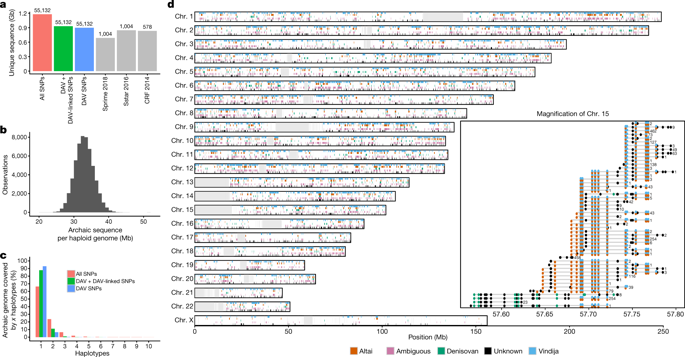Our official English website, www.x-mol.net, welcomes your
feedback! (Note: you will need to create a separate account there.)
The nature of Neanderthal introgression revealed by 27,566 Icelandic genomes
Nature ( IF 50.5 ) Pub Date : 2020-04-22 , DOI: 10.1038/s41586-020-2225-9 Laurits Skov 1, 2 , Moisès Coll Macià 1 , Garðar Sveinbjörnsson 3 , Fabrizio Mafessoni 2 , Elise A Lucotte 1 , Margret S Einarsdóttir 3 , Hakon Jonsson 3 , Bjarni Halldorsson 3, 4 , Daniel F Gudbjartsson 3 , Agnar Helgason 3, 5 , Mikkel Heide Schierup 1 , Kari Stefansson 3, 6
Nature ( IF 50.5 ) Pub Date : 2020-04-22 , DOI: 10.1038/s41586-020-2225-9 Laurits Skov 1, 2 , Moisès Coll Macià 1 , Garðar Sveinbjörnsson 3 , Fabrizio Mafessoni 2 , Elise A Lucotte 1 , Margret S Einarsdóttir 3 , Hakon Jonsson 3 , Bjarni Halldorsson 3, 4 , Daniel F Gudbjartsson 3 , Agnar Helgason 3, 5 , Mikkel Heide Schierup 1 , Kari Stefansson 3, 6
Affiliation

|
Human evolutionary history is rich with the interbreeding of divergent populations. Most humans outside of Africa trace about 2% of their genomes to admixture from Neanderthals, which occurred 50–60 thousand years ago 1 . Here we examine the effect of this event using 14.4 million putative archaic chromosome fragments that were detected in fully phased whole-genome sequences from 27,566 Icelanders, corresponding to a range of 56,388–112,709 unique archaic fragments that cover 38.0–48.2% of the callable genome. On the basis of the similarity with known archaic genomes, we assign 84.5% of fragments to an Altai or Vindija Neanderthal origin and 3.3% to Denisovan origin; 12.2% of fragments are of unknown origin. We find that Icelanders have more Denisovan-like fragments than expected through incomplete lineage sorting. This is best explained by Denisovan gene flow, either into ancestors of the introgressing Neanderthals or directly into humans. A within-individual, paired comparison of archaic fragments with syntenic non-archaic fragments revealed that, although the overall rate of mutation was similar in humans and Neanderthals during the 500 thousand years that their lineages were separate, there were differences in the relative frequencies of mutation types—perhaps due to different generation intervals for males and females. Finally, we assessed 271 phenotypes, report 5 associations driven by variants in archaic fragments and show that the majority of previously reported associations are better explained by non-archaic variants. Analysis of Icelandic genomes reveals chromosome fragments of Neanderthal and Denisovan origin, the latter of which occurred through Denisovan gene flow either into ancestors of the Neanderthals or directly into humans.
中文翻译:

27,566 个冰岛基因组揭示的尼安德特人基因渗入的性质
人类进化历史丰富,有不同种群的杂交。非洲以外的大多数人的基因组中约有 2% 来自尼安德特人的混合物,这发生在 50-60000 年前 1 。在这里,我们使用在来自 27,566 名冰岛人的全定相全基因组序列中检测到的 1,440 万个假定的古老染色体片段来检查该事件的影响,对应于 56,388-112,709 个独特的古老片段,覆盖了可调用基因组的 38.0-48.2% . 基于与已知古老基因组的相似性,我们将 84.5% 的片段分配给 Altai 或 Vindija Neanderthal 起源,3.3% 分配给 Denisovan 起源;12.2% 的碎片来源不明。通过不完整的谱系分类,我们发现冰岛人拥有比预期更多的类似丹尼索瓦人的碎片。这最好通过丹尼索瓦人的基因流来解释,要么进入基因渗入的尼安德特人的祖先,要么直接进入人类。古代片段与同线非古代片段的个体内成对比较显示,虽然人类和尼安德特人在他们谱系分离的 50 万年中的总体突变率相似,但它们的相对频率存在差异。突变类型——可能是由于雄性和雌性的世代间隔不同。最后,我们评估了 271 种表型,报告了由古老片段中的变体驱动的 5 个关联,并表明大多数先前报告的关联可以由非古老变体更好地解释。冰岛基因组分析揭示了尼安德特人和丹尼索瓦人起源的染色体片段,
更新日期:2020-04-22
中文翻译:

27,566 个冰岛基因组揭示的尼安德特人基因渗入的性质
人类进化历史丰富,有不同种群的杂交。非洲以外的大多数人的基因组中约有 2% 来自尼安德特人的混合物,这发生在 50-60000 年前 1 。在这里,我们使用在来自 27,566 名冰岛人的全定相全基因组序列中检测到的 1,440 万个假定的古老染色体片段来检查该事件的影响,对应于 56,388-112,709 个独特的古老片段,覆盖了可调用基因组的 38.0-48.2% . 基于与已知古老基因组的相似性,我们将 84.5% 的片段分配给 Altai 或 Vindija Neanderthal 起源,3.3% 分配给 Denisovan 起源;12.2% 的碎片来源不明。通过不完整的谱系分类,我们发现冰岛人拥有比预期更多的类似丹尼索瓦人的碎片。这最好通过丹尼索瓦人的基因流来解释,要么进入基因渗入的尼安德特人的祖先,要么直接进入人类。古代片段与同线非古代片段的个体内成对比较显示,虽然人类和尼安德特人在他们谱系分离的 50 万年中的总体突变率相似,但它们的相对频率存在差异。突变类型——可能是由于雄性和雌性的世代间隔不同。最后,我们评估了 271 种表型,报告了由古老片段中的变体驱动的 5 个关联,并表明大多数先前报告的关联可以由非古老变体更好地解释。冰岛基因组分析揭示了尼安德特人和丹尼索瓦人起源的染色体片段,






























 京公网安备 11010802027423号
京公网安备 11010802027423号